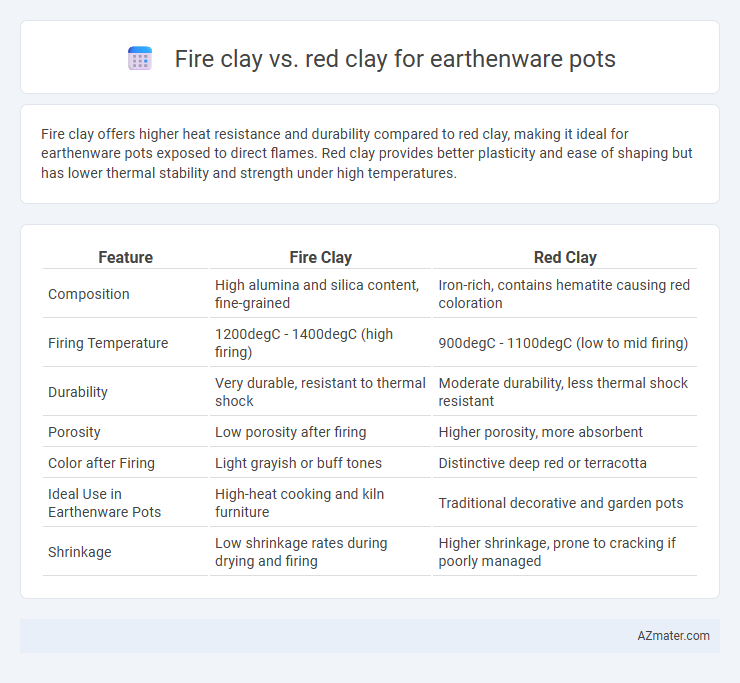Fire clay offers higher heat resistance and durability compared to red clay, making it ideal for earthenware pots exposed to direct flames. Red clay provides better plasticity and ease of shaping but has lower thermal stability and strength under high temperatures.
Table of Comparison
| Feature | Fire Clay | Red Clay |
|---|---|---|
| Composition | High alumina and silica content, fine-grained | Iron-rich, contains hematite causing red coloration |
| Firing Temperature | 1200degC - 1400degC (high firing) | 900degC - 1100degC (low to mid firing) |
| Durability | Very durable, resistant to thermal shock | Moderate durability, less thermal shock resistant |
| Porosity | Low porosity after firing | Higher porosity, more absorbent |
| Color after Firing | Light grayish or buff tones | Distinctive deep red or terracotta |
| Ideal Use in Earthenware Pots | High-heat cooking and kiln furniture | Traditional decorative and garden pots |
| Shrinkage | Low shrinkage rates during drying and firing | Higher shrinkage, prone to cracking if poorly managed |
Introduction to Earthenware Pottery Clays
Fire clay and red clay are popular choices for earthenware pottery due to their unique properties and composition. Fire clay contains high amounts of alumina and silica, providing excellent heat resistance and durability, making it ideal for cookware and kiln-fired pottery. Red clay, rich in iron oxide, offers vibrant color and plasticity, favored for decorative earthenware but less heat-resistant compared to fire clay.
What is Fire Clay?
Fire clay is a type of refractory clay with high alumina and silica content, enabling it to withstand intense heat without cracking or melting, making it ideal for crafting durable earthenware pots. It differs from red clay, which typically contains more iron oxide, giving it its characteristic color but less heat resistance. Fire clay's heat-retentive and thermal shock-resistant properties make it preferred for cooking vessels used over open flames or in high-temperature environments.
What is Red Clay?
Red clay is a natural earthenware material rich in iron oxide, which gives it its distinctive reddish color and enhances its durability for pottery. This type of clay is often preferred for creating rustic, traditional earthenware pots due to its excellent plasticity and heat retention properties. Compared to fire clay, red clay typically fires at lower temperatures, resulting in a more porous, less vitrified finish ideal for decorative and functional pots.
Key Mineral Composition: Fire Clay vs Red Clay
Fire clay contains higher amounts of alumina (Al2O3) and silica (SiO2), making it more refractory and ideal for high-temperature applications in earthenware pots. Red clay is rich in iron oxide (Fe2O3), giving it its characteristic red color but lower refractoriness compared to fire clay. The mineral composition difference results in fire clay being more durable and heat-resistant, while red clay offers better plasticity and ease of shaping in pottery.
Firing Temperature Differences
Fire clay typically requires a higher firing temperature, around 1200degC to 1300degC, making it more suitable for durable, heat-resistant earthenware pots. In contrast, red clay fires at lower temperatures, approximately 900degC to 1100degC, resulting in a softer, more porous pot ideal for decorative or low-heat uses. These temperature differences directly affect the strength, porosity, and thermal resistance of the finished earthenware products.
Color and Aesthetic Outcomes
Fire clay, characterized by its dense, fine texture, typically produces earthenware pots with a warm, reddish-brown color that deepens upon firing, offering a rich and rustic aesthetic. Red clay contains higher iron oxide, resulting in brighter, more vibrant red hues and often a slightly rougher surface, which adds a traditional and earthy appeal to pottery. Choosing between fire clay and red clay affects the final visual impact, with fire clay providing subtle, muted tones and red clay delivering bold, lively color outcomes.
Workability and Plasticity
Fire clay exhibits higher plasticity and superior workability compared to red clay, making it ideal for shaping intricate earthenware pots. Its fine particle size and balanced mineral composition enhance moldability and reduce cracking during drying and firing. Red clay, while workable, tends to be less plastic and may require blending with other clays to improve its forming characteristics for consistent earthenware production.
Durability and Strength Comparison
Fire clay exhibits superior durability and strength compared to red clay when used in earthenware pots, due to its higher alumina content and ability to withstand higher firing temperatures. Red clay is softer and more porous, making it more prone to cracking and chipping under stress or thermal shock. The enhanced vitrification and lower porosity of fire clay result in a more robust, long-lasting earthenware product suitable for intense use.
Best Uses: When to Choose Fire Clay or Red Clay
Fire clay, known for its high heat resistance and durability, is ideal for earthenware pots used in high-temperature cooking like baking or slow roasting, ensuring longevity and thermal stability. Red clay, rich in iron oxide, is best suited for decorative earthenware and low-heat cooking, such as simmering or serving, due to its porous nature and distinctive reddish hue. Choose fire clay for functional cookware requiring heat endurance, and opt for red clay when aesthetic appeal and moderate heat use are prioritized.
Conclusion: Selecting the Right Clay for Your Earthenware Pots
Fire clay offers superior heat resistance and durability, making it ideal for earthenware pots used in high-temperature cooking or baking. Red clay provides excellent plasticity and natural warmth, suitable for decorative or low-heat applications. Choosing between fire clay and red clay depends on the intended use, with fire clay favored for functional cookware and red clay preferred for aesthetic and traditional pottery.

Infographic: Fire clay vs Red clay for Earthenware pot
 azmater.com
azmater.com